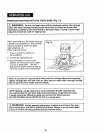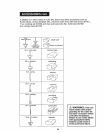
FEEDING THE ROUTER (Fig. 15)
The secret to professional routing is in making a careful set-up for the cut, selecting the
proper depth of cut, knowing how the cutter bit reacts in your workpiece, and the rate and
direction of feed of the router°
.< ROUTER EED ®
DIRECTION
Fig. 15
Q
ROUT
END
GRAINS
FIRST
CUTTER
BIT
(_ ROUT,ER FEED
DIRECTION
DIRECTION OF FEED - EXTERNAL CUTS (Fig. 15)
The router motor and cutter bit rotate clockwise. This requires the feed of the cutter bit to
be from left to right (see Fig. 15). Feeding the bit from left to right will cause the bit to pull
the router towards (up against) the workpiece.
tf you feed the router in the opposite direction (right to left), the rotating force of the
cutter bit will tend to throw the bit away from the workpiece, making it hard to control;
this is called "Climb-Cutting'; cutting in the opposite direction of the proper feed direction.
"Climb Cutting" increases the chance for toss of control, resulting in possible personal
injury. When "Climb Cutting" is required (backing around a corner for example), exercise
extreme caution to maintain control of the router.
Because of the high speed of the cutter bit during a proper feeding operation (left to right),
there is very little kickback under normal conditions. However, if the cutter bit strikes a knot,
an area of hard grain in the wood workpiece, or a foreign object, the normal cutting action
could be affected and cause "Kickback".
This Kickback may cause damage to your workpiece, and could cause you to lose control
of the router, causing possible personal injury. Kickback is always in the opposite direction
of the clockwise cutter bit rotation, or counterclockwise.
To guard against and help prevent Kickback, plan your set-up and direction of feed so
you're always thrusting the router, keeping the sharp edges of the cutter bit continuously
biting straight into new (uncut) wood (workpiece)o Also, always inspect your workpiece for
knots, hard grain, and foreign objects that could cause a kickback problem.
26


















